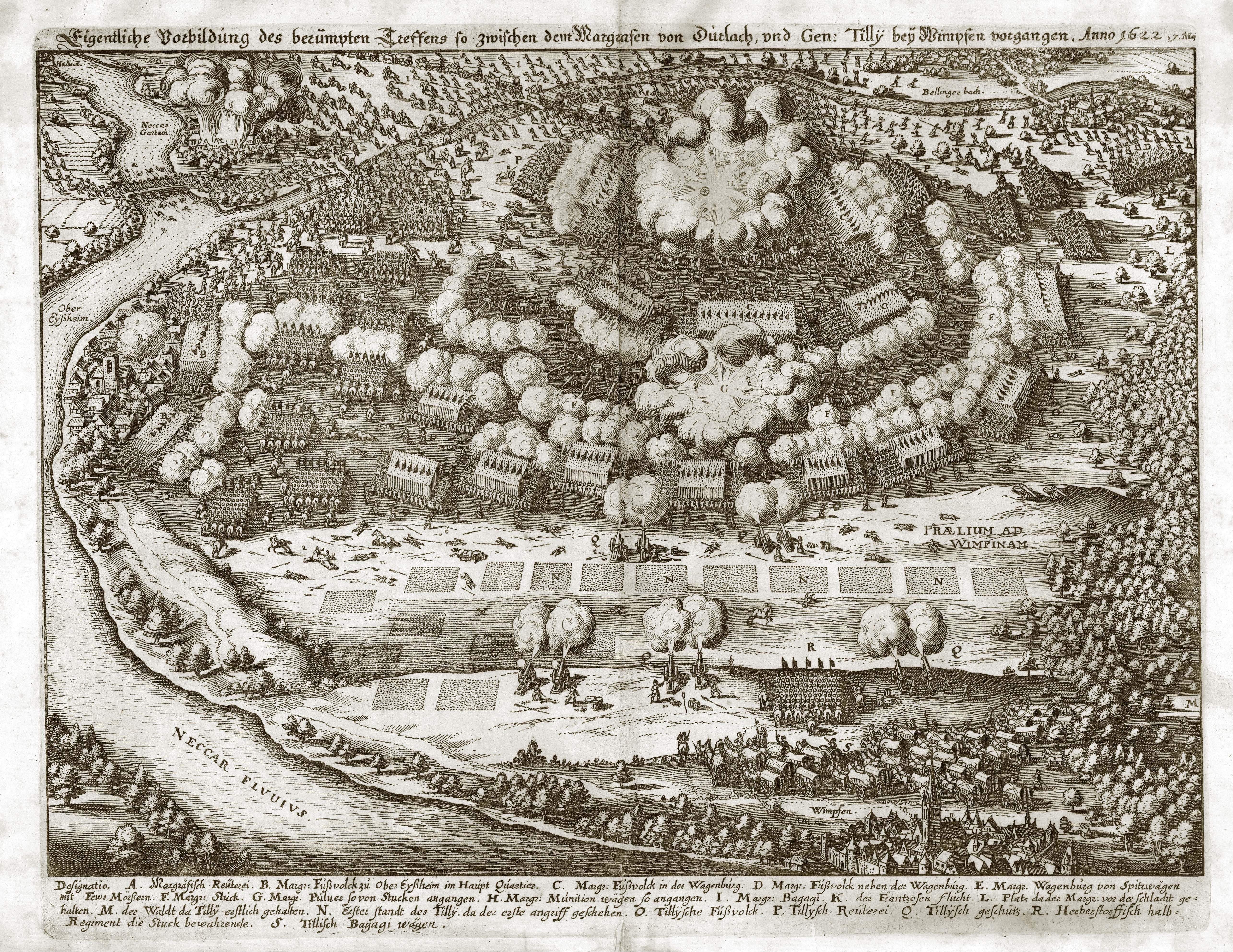Painting of the Battle of Vimpfen (or Wimpfen)
I saw this painting on a recent
post from the Wars of Louis XIV blog. Every now and then that blog has a
post about something from a time prior to the Sun King's reign. This painting
was particularly nice as it illustrated more than just the formations of
troops. Notice the wagons and tents in the center and center-right part of the
painting.
It turns out that the wagons and tents were an important focus in the battle as we will see in the following etching which shows the tremendous explosions that resulted from the accidental detonation of the Protestant magazine.
The Battle of Wimpfen. Etching from Merian's Theatrum
Europaeum,
vol. 1, 3rd ed. 1662, after p. 692
vol. 1, 3rd ed. 1662, after p. 692
Battle of Wimpfen
The Battle of Wimpfen was part of the Bohemian Revolt in the early portion of the Thirty Years' War. It occurred on May 6, 1622 near Wimpfen. The forces of the
Holy Roman Empire and the Catholic League under Marshal Tilly and Gonzalo de
Córdoba defeated the Protestant forces of General Ernst von Mansfeld and GeorgFriedrich, Margrave of Baden-Durlach.
Friedrich
After the fall of the Bohemian capital of Prague following
the Battle of White Mountain on November 8, 1620, Georg Friedrich decided to continue the fight. and oppose Tilly and Cordoba at Wimpfen.
On 27 April, George Frederick declared war on the Habsburgs and combined his forces with those of Mansfeld, so as to fight the Catholic League together. By early May, the soldiers of Christian of Brunswick had arrived to the north of the Neckar River and were prepared to assist the Protestant forces. This came as good news to the combined forces of Mansfeld and Georg Friedrich, who hoped to combine their armies before risking a major battle.
On 27 April, George Frederick declared war on the Habsburgs and combined his forces with those of Mansfeld, so as to fight the Catholic League together. By early May, the soldiers of Christian of Brunswick had arrived to the north of the Neckar River and were prepared to assist the Protestant forces. This came as good news to the combined forces of Mansfeld and Georg Friedrich, who hoped to combine their armies before risking a major battle.
To gain time and to attempt to split the combined Catholic
army, Mansfeld crossed the Neckar near Heidelberg while Georg Friedrich marched
east up the river to cross at Wimpfen. The plan failed as the troops under
Tilly and Córdoba did not split and instead pursued the 14,000 strong army of
Georg Friedrich and cut him off near Wimpfen. Outnumbered, Georg Friedrich
deployed his troops into a defensive position on a low hill outside of the
village. Here the Protestants made an effective stand, rallied by a strong
artillery position until a random Spanish countershot exploded the Protestant
magazine, costing the Badeners their position. The Catholics assaulted the hill and
shattered the Protestant army. Georg Friedrich then fled to Stuttgart with the few remaining men under his command.
Who is the artist of the first painting?
The Wars of Louis XIV blog post identifies the painter as Simon de Vos
possibly based on this
link or maybe this one. However the web site for the State
Hermitage Museum in St. Petersburg identifies the artist as Sebastiaen Vrancx.
The Wikipedia article on Sebastiaen Vrancx
also identifies him as the artist. It further observes that he was well known for
painting battle scenes which would support him as a likely artist. On the other hand, the neither the English nor the Netherlander Wikipedia articles on Simon de Vos mention the Battle of Vimpfen (or Wimpfen) at all.
Also of note is that the entry for the Hermitage contains the following “Acquisition date: Entered the Hermitage in 1933; transferred from the Antikvariat All-Union Association.” The two links that identify Simon de Vos as the artist both list "Source: All-Union Society 'Antiquariat', 1933." Since the Hermitage acquired the painting from the All-Union Society I'm going to assume that the attribution was later changed to Sebastiaen Vrancx and since that is the attribution used by the current holder of the painting, I conclude that Vrancx, not de Vos, is the actual artist.
Also of note is that the entry for the Hermitage contains the following “Acquisition date: Entered the Hermitage in 1933; transferred from the Antikvariat All-Union Association.” The two links that identify Simon de Vos as the artist both list "Source: All-Union Society 'Antiquariat', 1933." Since the Hermitage acquired the painting from the All-Union Society I'm going to assume that the attribution was later changed to Sebastiaen Vrancx and since that is the attribution used by the current holder of the painting, I conclude that Vrancx, not de Vos, is the actual artist.






